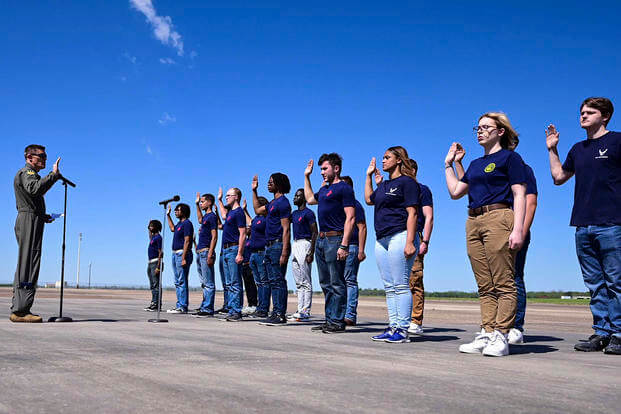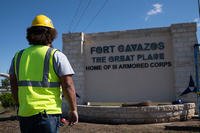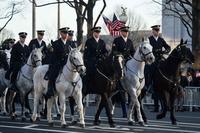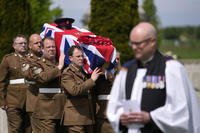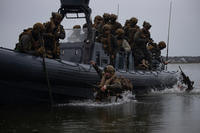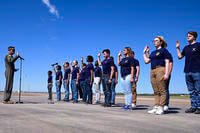Airmen who just joined the Air Force and want to do another job will get more options to keep them from leaving the service under a new policy, a move aimed at keeping the ranks filled amid a military-wide recruiting crisis and projected staffing shortages.
Starting June 1, first-term-airmen -- a phrase used to describe service members still working under their initial four-year or six-year contract -- can switch into another career field as long as at least 10% of the positions in that specialty are unfilled.
"Glad to see us make this change as it relates to retraining opportunities for the force," Chief Master Sergeant of the Air Force JoAnne S. Bass said in a Friday press release. "Providing these opportunities for our Airmen helps us keep talent on the bench."
Read Next: Air Force Will Allow More Body Fat for Recruits as Service Struggles to Find New Airmen
The initiative comes as the Air Force struggles to fill some career fields and also as it predicts it will miss its recruiting goals for the active duty, reserve and Air National Guard by a significant margin.
Other recent changes have included updating body fat composition requirements, amending tattoo policies and allowing certain applicants who test positive for THC -- the psychoactive component found in marijuana -- to retest and join the ranks if they're clean.
Retired Chief Master Sgt. Eric Benken, who served as the Air Force's top enlisted leader from 1996 to 1999, told Military.com in an interview Monday that he believes the move is tied to the Air Force's recruiting woes.
Benken said that when he first joined the service in the 1970s, it was more common to be told what job you'd have versus getting freedom of choice in deciding what specialty code you wanted.
"They're finding creative ways to recruit," Benken said. "I suspect that nowadays, they're saying, 'OK, we really want to keep you. And so in order to do that, we're going to broaden the scope on the number of career fields that are going to be available to you.'"
Traditionally, there was a list of available jobs that an airmen could retrain for, but those options were often limited.
Those qualified will no longer have to face the First Term Airmen Retaining Selection Board during the application process and will be offered new jobs on a "first in, first out" basis during their eight-month retraining window, according to the press release.
Air Force documents detail that an airman with a four-year contract has an eight-month retraining window starting after they've served for 35 months and closing after 43 months of service. For six-year contracts, it starts after 59 months of service and closes after 67 months in uniform.
The Air Force did not immediately return a request for comment asking which career fields were under the 90% filled threshold that would be available to first-term airmen.
But an April 4 email from Air Force Recruiting Service Commander Maj. Gen. Ed Thomas, which was leaked on social media and has been verified as authentic by the Air Force, detailed a dire shortfall in several career fields and predicted nearly 3,000 jobs that could see vacancies.
Thomas estimated that there could be "1,800 empty maintainer jobs, 700 empty defender jobs, 300 in munitions and 100 in fuel" if the recruiting environment doesn't get better.
"In the coming years, our brothers and sisters in arms will be asked to carry the burden intended for teammates who never joined our team," Thomas wrote. "Airmen will almost certainly be asked to work longer hours, cover more shifts and make sacrifices in their personal lives to meet the mission demands essential to our national security."
The service, after barely meeting its active-duty recruiting goals last year, announced in March it was projecting a 10% shortfall in the ranks and even more for the Air Force Reserve and Air National Guard. That's the equivalent of around 5,000 people, nearly the total of all the airmen at the 366th Fighter Wing stationed at Mountain Home Air Force Base, Idaho.
The Air Force Recruiting Services has pointed to numerous headwinds that have made it hard to bring in new members: Americans are seeing some of the lowest unemployment rates in more than 50 years, and the Pentagon has released studies showing that only 23% of American youth are eligible to serve right now.
The Air Force Recruiting Service said, overall, that less than 10% of the young population is interested in serving in the first place, and 50% can't name all the military service branches.
A slew of recent policy proposals and revisions has been approved, aimed at reversing that trend.
Last month, the Air Force announced it will allow recruits to have a greater percentage of body fat, but they're still expected to meet the same fitness standards as everyone else to stay in the service.
In March, the Department of the Air Force announced it is now allowing tattoos on the neck and hands, a policy change aimed at bringing younger talent into the ranks.
And last year, the Air Force and Space Force announced a new pilot program that would grant certain highly qualified and otherwise perfect applicants who test positive for THC a chance to retest and possibly join the ranks.
-- Thomas Novelly can be reached at thomas.novelly@military.com. Follow him on Twitter @TomNovelly.

